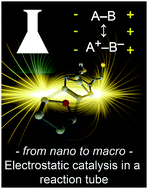当前位置:
X-MOL 学术
›
Chem. Soc. Rev.
›
论文详情
Our official English website, www.x-mol.net, welcomes your
feedback! (Note: you will need to create a separate account there.)
Harnessing electrostatic catalysis in single molecule, electrochemical and chemical systems: a rapidly growing experimental tool box†
Chemical Society Reviews ( IF 40.4 ) Pub Date : 2018-06-27 00:00:00 , DOI: 10.1039/c8cs00352a Simone Ciampi 1, 2, 3, 4, 5 , Nadim Darwish 1, 2, 3, 4, 5 , Heather M. Aitken 5, 6, 7, 8, 9 , Ismael Díez-Pérez 1, 10, 11, 12, 13 , Michelle L. Coote 5, 6, 7, 8, 9
Chemical Society Reviews ( IF 40.4 ) Pub Date : 2018-06-27 00:00:00 , DOI: 10.1039/c8cs00352a Simone Ciampi 1, 2, 3, 4, 5 , Nadim Darwish 1, 2, 3, 4, 5 , Heather M. Aitken 5, 6, 7, 8, 9 , Ismael Díez-Pérez 1, 10, 11, 12, 13 , Michelle L. Coote 5, 6, 7, 8, 9
Affiliation

|
Static electricity is central to many day-to-day practical technologies, from separation methods in the recycling of plastics to transfer inks in photocopying, but the exploration of how electrostatics affects chemical bonding is still in its infancy. As shown in the Companion Tutorial, the presence of an appropriately-oriented electric field can enhance the resonance stabilization of transition states by lowering the energy of ionic contributors, and the effect that follows on reaction barriers can be dramatic. However, the electrostatic effects are strongly directional and harnessing them in practical experiments has proven elusive until recently. This tutorial outlines some of the experimental platforms through which we have sought to translate abstract theoretical concepts of electrostatic catalysis into practical chemical technologies. We move step-wise from the nano to the macro, using recent examples drawn from single-molecule STM experiments, surface chemistry and pH-switches in solution chemistry. The experiments discussed in the tutorial will educate the reader in some of the viable solutions to gain control of the orientation of reagents in that field; from pH-switchable bond-dissociations using charged functional groups to the use of surface chemistry and surface-probe techniques. All of these recent works provide proof-of-concept of electrostatic catalysis for specific sets of chemical reactions. They overturn the long-held assumption that static electricity can only affect rates and equilibrium position of redox reactions, but most importantly, they provide glimpses of the wide-ranging potential of external electric fields for controlling chemical reactivity and selectivity.
中文翻译:

利用单分子,电化学和化学系统中的静电催化:快速发展的实验工具箱†
从塑料回收中的分离方法到影印中的转移油墨,静电对许多日常实用技术都是至关重要的,但是对静电如何影响化学键合的探索仍处于起步阶段。如《同伴指南》中所示,适当定向的电场的存在可以通过降低离子贡献剂的能量来增强过渡态的共振稳定性,并且随后对反应势垒的影响也非常明显。但是,静电效应具有很强的方向性,直到最近,在实际实验中利用静电效应还是难以捉摸的。本教程概述了一些实验平台,我们试图通过这些实验平台将静电催化的抽象理论概念转化为实用的化学技术。我们使用从单分子STM实验,表面化学和溶液化学中的pH转换中提取的最新示例,逐步从纳米向宏观移动。本教程中讨论的实验将教育读者一些可行的解决方案,以控制该领域中试剂的方向。从使用带电官能团的pH可转换键解离到表面化学和表面探针技术的使用。所有这些最新的工作为特定的化学反应提供了静电催化的概念证明。他们推翻了一个长期存在的假设,即静电只会影响氧化还原反应的速率和平衡位置,但最重要的是,
更新日期:2018-06-27
中文翻译:

利用单分子,电化学和化学系统中的静电催化:快速发展的实验工具箱†
从塑料回收中的分离方法到影印中的转移油墨,静电对许多日常实用技术都是至关重要的,但是对静电如何影响化学键合的探索仍处于起步阶段。如《同伴指南》中所示,适当定向的电场的存在可以通过降低离子贡献剂的能量来增强过渡态的共振稳定性,并且随后对反应势垒的影响也非常明显。但是,静电效应具有很强的方向性,直到最近,在实际实验中利用静电效应还是难以捉摸的。本教程概述了一些实验平台,我们试图通过这些实验平台将静电催化的抽象理论概念转化为实用的化学技术。我们使用从单分子STM实验,表面化学和溶液化学中的pH转换中提取的最新示例,逐步从纳米向宏观移动。本教程中讨论的实验将教育读者一些可行的解决方案,以控制该领域中试剂的方向。从使用带电官能团的pH可转换键解离到表面化学和表面探针技术的使用。所有这些最新的工作为特定的化学反应提供了静电催化的概念证明。他们推翻了一个长期存在的假设,即静电只会影响氧化还原反应的速率和平衡位置,但最重要的是,











































 京公网安备 11010802027423号
京公网安备 11010802027423号